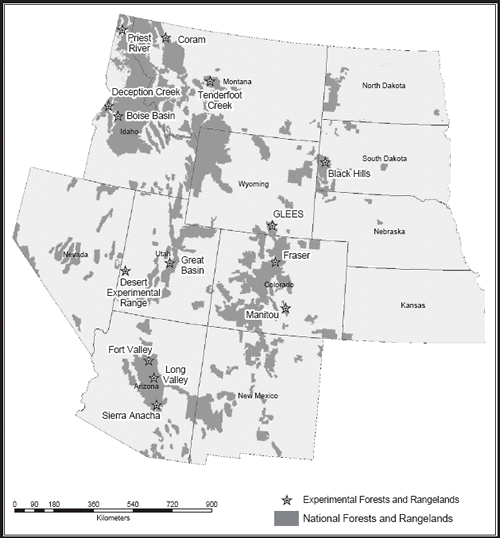


 Rocky Mountain Research Station
Rocky Mountain Research Station
|
|
 Science Program Areas
Science Program Areas
|
|
 Hot Topic: Climate Change
Hot Topic: Climate Change
|
|
 Hot Topic: Aspen
Hot Topic: Aspen
|
|
 Research Laboratories
Research Laboratories
|
|
 Tools, Applications and Data
Tools, Applications and Data
|
|
 People
People
|
|
 About RMRS
About RMRS
|
|
 Contact RMRS
Contact RMRS
|
|
 Search
Search
|
|
 Congressional Notebook
Congressional Notebook
|
 RMRS Publications
RMRS Publications
|
 Experimental Forests
Experimental Forests
|
 Partnerships
Partnerships
|
 US Forest Service Links
US Forest Service Links
|
 RMRS Archives
RMRS Archives
|
|
|


|
|
Home > Experimental ForestsExperimental ForestsScience makes the US Forest Serviceunique. The ability to conduct scientific research in-house, to apply research findings on the National Forest System lands, and to transfer them to others for use on all of the nation's forest land sets the Forest Service apart as a natural resource agency. A unique and exceedingly valuable part of the infrastructure in place to conduct this research is the national network of experimental forests and ranges, a land base authorized by Congress and designated by the Chiefs of the Forest Service over the last 100 years. These experimental forests and ranges are not historical relics, but the sites for most of the longterm research conducted by Forest Service Research and Development and our partners. The experimental forests and ranges are living laboratories where Forest Service scientists not only make discoveries but also demonstrate research results for cooperators and stakeholders. They provide the opportunity to conduct the bold, imaginative research that will be required for the future. The Rocky Mountain Research Station administers and conducts research on 14 experimental forests and ranges:

Experimental forests and ranges (and other experimental areas within this network) remain as some of the few places where ecological research can be maintained over the long term. This kind of protection allows for experiments that can last longer than an individual scientist's career. For example, at the H.J. Andrews Experimental Forest in Oregon, a study of log decomposition that was established in 1982 is expected to last for 200 years! The existence of these experimental forests and ranges allows for long-term data to be collected, and for us to learn how forests change over time as climate and other factors change. At the Bartlett Experimental Forest in New Hampshire, 500 growth plots were laid in a grid across the forest in 1931. Remeasurements of these plots have helped us better learn how to manage forests that are dynamic and subject to a variety of stresses over time. Because experimental forests and ranges often encompass whole watersheds and large areas, it is possible to do landscape-scale experiments. Finally, operating as a network of ecological research sites representing a wide range of forest and range types allows scientists to conduct cross-site comparisons, to help leverage funding, and to evaluate landscape patterns and processes at landscape to regional scales. Experimental forests and ranges are extremely varied, and are located throughout the United States and Puerto Rico. They are as small as 47 ha (Kawishiwi Experimental Forest in Minnesota) and as large as 22,500 ha (Desert Experimental Range in Utah). They range from boreal forests (Bonanza Creek Experimental Forest in Alaska) to tropical forests (Luquillo Experimental Forest in Puerto Rico) to dry desert ranges (Great Basin Experimental Range in Utah). Long-term records on many of these experimental forests and ranges date back to the 1930s when 29 of the 77 were established. The oldest research records date back to 1911 (Priest River Experimental Forest in Idaho) and 1912 (Great Basin Experimental Range in Utah), whereas the newest experimental forests were designated in the early 1970s (McCormick Experimental Forest in 1970 and Entiat Experimental Forest in 1971). Such diversity is a hallmark and a strength of the network of experimental forests and ranges. |
|
||||||||||||||||||
|
The material for the Experimental Forests pages was originally published in: Adams, Mary Beth; Loughry, Linda; Plaugher, Linda, comps. 2004.
Experimental Forests and Ranges of the USDA Forest Service.
Gen. Tech. Rep. NE-321. Newtown Square, PA: U.S. Department of Agriculture, Forest Service, Northeastern Research Station. 178 p.
GTR-NE-321 - 5.5 mb pdf Information has been updated since original publication. | |||||||||||||||||||
Rocky Mountain Research Station
Last Modified: Monday, 28 April 2008 at 17:14:25 EDT (Version 1.0.5)